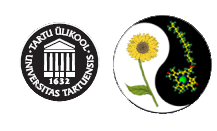 English
English Eesti
Eesti
Unraveling the hidden nature of photosynthetic antenna excitations
The three main parameters that determine the electronic structure and dynamics of the photosynthetic antenna excitations are the resonant (exciton) coupling energy, the inhomogeneous spectral broadening, and the exciton-lattice coupling energy. Generally, information about these factors can be obtained by optical spectroscopy. However, in conventional optical spectroscopy only ensemble-averaged data are accessible. Adequate theoretical modeling is, therefore, required to uncover various hidden parameters. The present studies focus on the peripheral LH2 and core LH1 antenna complexes from purple bacteria. These bacteriochlorophyll-containing antennas show quasi-linear optical spectra that allow detailed spectroscopic studies not only at cryogenic temperatures but at physiological temperatures as well. The strongly overlapping chlorophyll spectra in higher plant antennas are in that respect much less informative. Secondly, the bacterial antennas present wonderfully ordered quasi- one-dimensional structures of pigment molecules amenable for straightforward physical modeling. Complexity of the antennas and incomplete structural data render similar level of multi-parameter modeling in higher plants more challenging. We found that the generally applied disordered Frenkel exciton model, while sufficient for describing steady-state absorption spectra, falls short in characterization of the fluorescence emission properties of the bacterial antennas. Therefore, an excitonic polaron model is introduced, much better suitable for description of the relaxed excited electronic states in the disordered one-dimensional bacteriochlorophyll aggregates representing the emitting antenna structures with relatively strong interaction between excitons and lattice vibrations. The static disorder considerable reduces critical exciton-lattice coupling energy required for initiation of the smooth exciton self-trapping transition. It also allows coexistence of multiple self-trapped excitons in the same lattice. Such a situation in regular structures is only possible at higher dimensions. The discovered exciton self-trapping might promote energy transport and trapping processes in bacterial photosynthesis by broadening the LH2 and LH1 antenna spectra and by maximizing their fluorescence emission rate. ( Photosynthesis in Silico )
